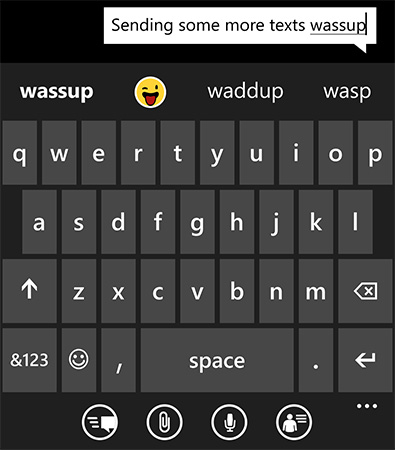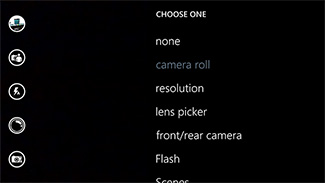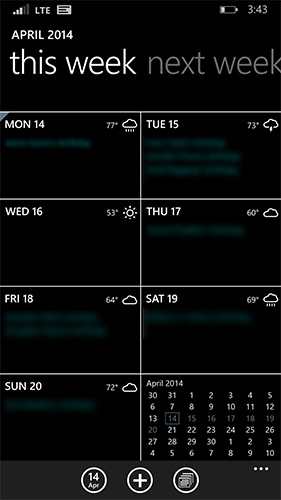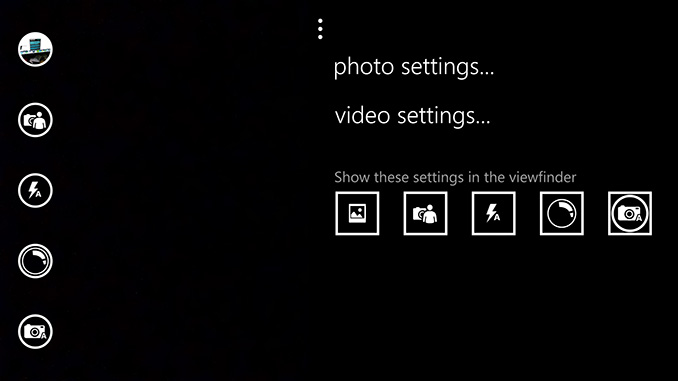Windows Phone 8.1 Review
by Anand Lal Shimpi on April 14, 2014 10:00 PM EST- Posted in
- Smartphones
- Microsoft
- Mobile
- windows phone
- Windows Phone 8.1
Word Flow Keyboard with Shape Writing Support
The keyboard in WP8.1 gets a pretty big update with the addition of shape writing support. Similar to Swype, SwiftKey Flow and other systems on Android, instead of tapping individual letters on the Word Flow keyboard you can now trace a path over the same letters to form a word. Instead of tapping out A-N-A-N-D, shape writing allows me to start with my finger on A, trace down and to the right to hit N, trace back to hit A, go down/to the right again to hit N, and then drag my thumb/finger one last time to the left and land on the D key before finally lifting off.

Although new to Windows Phone, shape writing has been around for years on other platforms including Android. The implementation on WP8.1 is excellent however. Shape writing does a great job of leveraging Windows Phone’s predictive text engine. I found that right off the bat I made almost no mistakes while shape writing on WP8.1’s Word Flow keyboard. I could just draw on the screen with my thumb without ever having to look to make sure what I was typing was correct. The only times shape writing didn’t work for me were if I was trying to spell a word that wasn’t yet in the dictionary, or if I was trying to use a contraction that wasn’t immediately obvious (e.g. it’s vs. its). The Word Flow keyboard is extremely quick at adding corrections to its database, so most mistakes happen one time only.
As far as performance goes, I’m still faster at two thumb typing than I am with shape writing. Compared to me typing with a single thumb however, shape writing is substantially quicker. I went through a simple one line typing test several times in all three configurations and recorded my average typing speed on the Nokia Lumia Icon WP8.1 dev preview device:
| Windows Phone 8.1 Word Flow Keyboard Typing Speed | ||||||
| One Handed | One Handed Shape Writing | Two Handed | ||||
| Typing Rate (Higher is Better) | ~41 wpm | ~51 wpm | ~60 wpm | |||
With Windows Phone 8, Microsoft added emoji support to the Word Flow keyboard. In WP8.1, emojis are part of the predictive text engine. If you type a word that has an emoji associate with it, you’ll see the emoji in the suggestion bar. Draw out a word with shape writing and the next suggestion will be the emoji representing that word (if one exists).

Autocorrect suggestions still won’t appear if you’re typing too quickly. If you’re typing above ~45 wpm you won’t see any suggestions. Drop below that point and they’ll populate in the suggestions bar.
Camera UI
The Camera UI in Windows Phone 8.1 sees a significant set of updates. Like Action Center, there are five customizable buttons directly on the camera UI. By default you get access to the camera roll, front facing camera, scenes, lenses and flash settings without first going into the overflow menu. Every single one of those buttons is customizable though.
 |
 |
There’s a new low resolution (1080p) burst mode that will capture 15 frames and allow you to save all or only the ones that you want. Unsaved frames are automatically deleted after a customizable period of time (7 days by default) or can be removed manually.
The improvements to the camera UI are nice but on devices like Nokia’s Lumia Icon you’re going to be using Nokia’s Camera app instead, making the enhancements more useful on lower end devices.
Calendar
I won’t spend too much time on the updated Calendar app other than to say that the new week view is awesome:

You get a glance at what you’re doing every day of the week, as well as a tiny view of the month as a whole. Swipe to the right to look at next week, and the week after that. Week view in WP8.1’s calendar app is probably one of the most useful things to me personally on any mobile platform. If you’re Apple or a player in the Android space: copy this feature.












111 Comments
View All Comments
DanNeely - Tuesday, April 15, 2014 - link
In the second set of image tests the no and standard image compression images appear identical. Did MS really manage to squeeze 10% out with no visible impact at all; or did you load the same image twice?EnzoFX - Tuesday, April 15, 2014 - link
So they should be at the bleeding edge in hardware, while focusing on the entry-level? That sounds a bit counter productive to me, but what do I know.I do agree it's great as entry-level, I have a 521, and love it for the basics and little I use it for. I don't want to do anything too complex, if I did I would use a tablet, in which case free tethering on Tmo is a god send.
Penti - Tuesday, April 15, 2014 - link
Their tie in with Qualcomm worked for Microsoft, it's one of the reasons Nokia's mobile business collapsed when they switched as they had been paying and cooperating with other semi-suppliers and much of what they did and their supply network went up in smoke thanks to it. They have already fired 30 000 employees and closed their manufacturing in Europe except for a few holding out in Hungary were most have been sacked. Uprooted how they design and manufacture and most of their supply network. What has survived is manufacturing in India and China, were they mostly has done Series 30/40 type of devices, the sub €50 market.However it didn't look like this for Microsoft's market position for a long time, other SoC-suppliers were pretty prevalent and they did lag even on getting the latest Qualcomm-chips. As Qualcomm-chips come in both new high-end variants and low-end it does make sense to be supported early, regardless of when the mass release is done on the new chip. It also hindered stuff like other screen resolutions. Basically features Nokia's Symbian had in 2010 is what Nokia's WP-phones get now, and some of the limitations Symbian had like semi-fixed resolution got carried on and still applies in 2014. Great for Microsoft which get the only Windows Phone brand for nothing, but for the market as a whole? For NA? Well it's low end devices in Europe and Asia that sells and in the States they don't sell millions of units per year as they – the low-end – haven't caught on over there. High-end is mostly a marketing vehicle for Microsoft I would say. Most of the people that has been proponents early on knew nothing about it's limitations and so those people weren't good ambassadors. Most moved on as it's been about 4 years since Mix 2010. Others like Blackberry moved out of the spotlight but has been able to create whole new platforms within the same time that had most of the necessary features from the first few releases which were out some time ago. Until now, with 8.1 which hasn't made a final release yet, Windows Phone hasn't really been a choice in an enterprise as it's (mobile) management features were worse then BB10, Android and iOS, which all three also supported Exchange much better, had better third-party support for things like sharepoint and lync and so on. S/MIME mail weren't doable until 8.1 for example. They haven't drawn on their strength's that is the rest of the Microsoft family. While they have a mobile Office suit, it's features really isn't any better than third party packages for Android, BB10 or iOS by now and enterprise features or favorites like VBA Macros or really big spreadsheets are a now go. Thus it really doesn't offer any advantages. But now it is at least workable to a much larger extent.
Sabresiberian - Tuesday, April 15, 2014 - link
Thanks for the review of 8.1 and the Icon. I've been wanting an Anandtech treatment because I believe this site is the best at detailing mobile phone hardware and software. You and Brian are also very good at moving prejudices or preferences to the side, expressing opinions as opinions and differentiating them from the facts. Well done.Penti - Tuesday, April 15, 2014 - link
Sadly Universal Apps are overblown, WinRT-framework still has it's limitations and while WinRT has been updated to the same as desktops it still is a two-projects in one solution, and if you don't do an mobile UI, or don't do a Store-UI (desktop metro) then it won't run there. Only part of the code is shared, the .NET version still requires portable class libraries and it's still built as one mobile app and one startscreen app from that project. WinRT (runtime) is sadly a limited abstraction of Win32 rather than anything else and it's still much weaker than iOS SDK or Android NDK/SDK, or Blackberry 10 Native SDK, or Jolla's Sailfish SDK. The phone still runs Win32 programs and the others don't need an API for internal apps such as browsers and a totally different one for developers of third party apps. On Android there pretty much only is Bionic-driven Native apps and apps on the Android framework through Dalvik/ART. WP still has two native frameworks and runtimes underneath it's system. The only thing it does anything better then at a technical level is probably the Bada-LiMo hybrid that is Tizen which is a mix of Bada C++ API's and EFL, which no one can relate to. It kinda is like if Nokia would bring back Symbian C++ API's, which they did replace with Qt the last few years it were around. Microsoft have to settle for the low-end market here, even if they actually can do corporate email now.Duraz0rz - Tuesday, April 15, 2014 - link
"it still is a two-projects in one solution, and if you don't do an mobile UI, or don't do a Store-UI (desktop metro) then it won't run there."Is that a bad thing? There are many instance of iOS or Android apps being developed for the phone and not scaling well to the tablet. You have to make design decisions between the two, especially since the phone is designed to be used (for the most part) in portrait mode, while tablets are designed to be used in landscape.
"it's still much weaker than iOS SDK or Android NDK/SDK, or Blackberry 10 Native SDK, or Jolla's Sailfish SDK."
Why are the iOS or Android SDKs better than the WinRT SDK?
LarsBars - Tuesday, April 15, 2014 - link
Windows Phone lagged behind Android in getting LTE support, but the Lumia 900 launched 5 months before the iPhone 5, which was the first Apple phone to have LTE.UsernameAlreadyExists - Wednesday, April 16, 2014 - link
They even had a review of it. http://www.anandtech.com/show/5724/nokia-lumia-900... Of course, maybe Anand didn't read it :)wrkingclass_hero - Tuesday, April 15, 2014 - link
"It’s no coincidence that the two players that do have that feature also derive revenue from selling advertising against user data."Didn't Apple buy Admob? Admob doesn't collect user data?
MikhailT - Wednesday, April 16, 2014 - link
http://www.google.com/ads/admob/Google owns Admob, so no, Apple didn't buy Admob. Were you thinking of a different company?